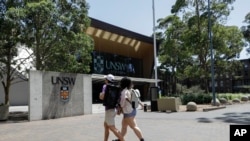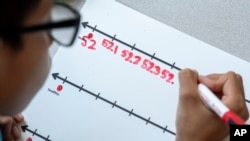Student Union
Crafting Your Art of English Fluency
When you’re not comfortably fluent in the language of your “new home,” a casual chat can rapidly turn into a rollercoaster of confusing words. I could barely even understand the information that the immigration officer told me when I landed in the U.S.
Now, after two years, I can proudly say that my English is lot better than it used to be, although I’m still trying to improve my speaking skills. To get there, I had to understand that assimilating to a language is an art. You have to feel it, visualize it, and experience it yourself. It’s an art that you create, not that you learn. Here are the four ways in which I have crafted my own art of fluency.
1. The Craft of Listening
Have you ever heard of leeches? There are slimy and tiny worm-like organisms that can suck human blood without even getting noticed. A leech will absorb as much blood as it pleases, and then instinctively lets go and begins its well-deserved digestion break.
I know, you must be wondering why I would talk about leeches in an article about learning English. But actually, those little creatures can teach us a lot about the approach to take when learning English. If you really want to be comfortable with daily spoken English, you have to start absorbing the language as much as you can.
It doesn’t matter how, where, or when. Just let yourself consume the language. It may feel like you’re not learning anything because you’re just hearing thousands of words you don’t understand, but trust me, your brain is subliminally integrating English into you.
I did this by watching television, turning up the radio, or even listening to strangers’ conversations — which is great until you get caught.
I also used an English-only dictionary to try to understand words in their proper context, rather than using a translation dictionary to learn what words meant in my native language (French).
One of my ESL instructors, Christiane Galvani, told us one day that every step we take towards our native language is a step backwards in English. Honestly, this is one of the best pieces of advice about language assimilation I’ve ever heard. It is so true; each time I was only speaking in French, it would hold me back from actually progressing in English.
2. The Craft of Watching
My other ESL instructor, Melanie Dando, used to tell us, “If you feel too comfortable, you’re probably speaking with an accent.”
One way to break the habit of speaking in your native accent is to watch videos on YouTube (or any other video site that has transcripts or captions) and try to emulate what the host is doing as you read from the transcript. I always try to exaggerate the sounds and overstress the pronunciations so I get more comfortable with the correct sounds.
It also helps if you do this in front of a mirror. This is another piece of advice from my ESL instructor Mrs. Galvani. Watching yourself as you speak helps you visualize the way you're moving your mouth. One thing I personally realized is that in English you have to hold your tongue a very particular way to pronounce certain words.
One of the most challenging sounds for me was the sound “th” in words such as “though,” “thus,” “through,” or “threat.” Sometimes that sound would come out sounding more like “v” in words like “the” or like “f” in words like “threat. At the beginning I felt really uncomfortable trying to mimic the correct tongue position, but that just meant I was breaking my incorrect habits. I tried to vary the way I moved my mouth until I figured out what worked best to let me make this sound.
I was really amazed when I discovered the proper way this sound should be voiced, although I still struggle to pronounce the word “thrust.” Watching and listening to myself as I practiced speaking also helped me notice that I project a better sound in English when I use a lower and deeper tone with my voice.
Practice always makes better, although NOT perfect, so I cannot stress enough how important practice is. Your mirror should become your best ESL friend - after all, you spend the majority of your time with yourself.
3. The Craft of Speaking
One thing that you need to understand as a foreigner is that you may never be able to visualize, understand, or even speak English the way the native people do. Native speakers have been speaking the language ever since they were toddlers. They have had the time to understand what’s to be said and what’s not. They can afford to speak English casually because they have a wide variety of contexts, situations, and experiences that have told them when, where, and how to use their language.
But we, as immigrants, do not have that freedom when learning English. We have to learn to communicate in English in 6 months or so, and it’s therefore important to pick up good linguistic habits early on. A great way to do so is to start off by speaking in formal English exclusively.
The other day, a classmate of mine, who is also a foreigner, asked our professor, “So, do we have to do this, or what?” I was literally in shock. It sounded very disrespectful to me as a way to address a professor. The professor answered the question normally, but I felt like this classmate had adopted a phrase used among friends that is not appropriate to use with authority figures.
This is why it’s important to trying to develop formal English at the beginning. It’s good to put constraints like these on the way you speak English. It may be difficult at first but your hard work will pay off eventually and you will have more freedom and choice in the way you speak English.
4. The Craft of Being Yourself
If you try to learn something you don’t like, you will always have a hard time. Since you will be living in an English-speaking country, you have no choice but to learn, and love, its language. But it’s always easier if you can relate it to something you are passionate about.
I love singing so much that I can devour any knowledge related to singing in enormous portions. I always find it easy to read about vocal terms and theory, and have found it a great way to learn English while devouring a topic I truly love. Whenever I start reading an article related to this subject, I always do so out of pure passion and hunger for knowledge. I can assure you than there’s nothing more rewarding than educating yourself about your own favorite topics of interest.
The funny thing is that most of the terms related to singing I have leaned in English are total strangers to me in my own native language.
Therefore, I encourage you to discover the things you are passionate about and to learn about them. It will make you learn not only about English, but also about your favorite subject.
It's all about finding the approaches that work best for you. Like art, learning a language is something that different people experience in different ways. From this article I want you to take away suggestions, not necessarily instructions. I believe that every person visualizes things in their own unique way, and so do you. So, get busy and craft your own art of fluency.
See all News Updates of the Day
America’s future diplomats forgoing foreign travel

U.S. students who want federal jobs as diplomats are skipping opportunities to study abroad or develop foreign contacts, according to a column in Foreign Policy.
Elizabeth Braw explains that government workers need security clearances, and students don’t want to complicate the process. Ultimately, their lack of expertise could hurt the nation. (May 2024)
Most US students are recovering from pandemic setbacks, but millions lag

On one side of the classroom, students circled teacher Maria Fletcher and practiced vowel sounds. In another corner, children read together from a book. Scattered elsewhere, students sat at laptop computers and got reading help from online tutors.
For the third graders at Mount Vernon Community School in Virginia, it was an ordinary school day. But educators were racing to get students learning more, faster, and to overcome setbacks that have persisted since schools closed for the COVID-19 pandemic four years ago.
America's schools have started to make progress toward getting students back on track. But improvement has been slow and uneven across geography and economic status, with millions of students — often those from marginalized groups — making up little or no ground.
Nationally, students made up one-third of their pandemic losses in math during the past school year and one-quarter of the losses in reading, according to the Education Recovery Scorecard, an analysis of state and national test scores by researchers at Harvard and Stanford.
But in nine states, including Virginia, reading scores continued to fall during the 2022-23 school year after previous decreases during the pandemic.
Clouding the recovery is a looming financial crisis. States have used some money from the historic $190 billion in federal pandemic relief to help students catch up, but that money runs out later this year.
"The recovery is not finished, and it won't be finished without state action," said Thomas Kane, a Harvard economist behind the scorecard. "States need to start planning for what they're going to do when the federal money runs out in September. And I think few states have actually started that discussion."
Virginia lawmakers approved an extra $418 million last year to accelerate recovery. Massachusetts officials set aside $3.2 million to provide math tutoring for fourth and eighth grade students who are behind grade level, along with $8 million for literacy tutoring.
But among other states with lagging progress, few said they were changing their strategies or spending more to speed up improvement.
Virginia hired online tutoring companies and gave schools a "playbook" showing how to build effective tutoring programs. Lisa Coons, Virginia's superintendent of public instruction, said last year's state test scores were a wake-up call.
"We weren't recovering as fast as we needed," Coons said in an interview.
U.S. Education Secretary Miguel Cardona has called for states to continue funding extra academic help for students as the federal money expires.
"We just can't stop now," he said at a May 30 conference for education journalists. "The states need to recognize these interventions work. Funding public education does make a difference."
In Virginia, the Alexandria district received $2.3 million in additional state money to expand tutoring.
At Mount Vernon, where classes are taught in English and Spanish, students are divided into groups and rotate through stations customized to their skill level. Those who need the most help get online tutoring. In Fletcher's classroom, a handful of students wore headsets and worked with tutors through Ignite Learning, one of the companies hired by the state.
With tutors in high demand, the online option has been a big help, Mount Vernon principal Jennifer Hamilton said.
"That's something that we just could not provide here," she said.
Ana Marisela Ventura Moreno said her 9-year-old daughter, Sabrina, benefited significantly from extra reading help last year during second grade, but she's still catching up.
"She needs to get better. She's not at the level she should be," the mother said in Spanish. She noted the school did not offer the tutoring help this year, but she did not know why.
Alexandria education officials say students scoring below proficient or close to that cutoff receive high-intensity tutoring help and they have to prioritize students with the greatest needs. Alexandria trailed the state average on math and reading exams in 2023, but it's slowly improving.
More worrying to officials are the gaps: Among poorer students at Mount Vernon, just 24% scored proficient in math and 28% hit the mark in reading. That's far lower than the rates among wealthier students, and the divide is growing wider.
Failing to get students back on track could have serious consequences. The researchers at Harvard and Stanford found communities with higher test scores have higher incomes and lower rates of arrest and incarceration. If pandemic setbacks become permanent, it could follow students for life.
The Education Recovery Scorecard tracks about 30 states, all of which made at least some improvement in math from 2022 to 2023. The states whose reading scores fell in that span, in addition to Virginia, were Nevada, California, South Dakota, Wyoming, Indiana, Oklahoma, Connecticut and Washington.
Only a few states have rebounded to pre-pandemic testing levels. Alabama was the only state where math achievement increased past 2019 levels, while Illinois, Mississippi and Louisiana accomplished that in reading.
In Chicago Public Schools, the average reading score went up by the equivalent of 70% of a grade level from 2022 to 2023. Math gains were less dramatic, with students still behind almost half a grade level compared with 2019. Chicago officials credit the improvement to changes made possible with nearly $3 billion in federal relief.
The district trained hundreds of Chicago residents to work as tutors. Every school building got an interventionist, an educator who focuses on helping struggling students.
The district also used federal money for home visits and expanded arts education in an effort to reengage students.
"Academic recovery in isolation, just through 'drill and kill,' either tutoring or interventions, is not effective," said Bogdana Chkoumbova, the district's chief education officer. "Students need to feel engaged."
At Wells Preparatory Elementary on the city's South Side, just 3% of students met state reading standards in 2021. Last year, 30% hit the mark. Federal relief allowed the school to hire an interventionist for the first time, and teachers get paid to team up on recovery outside working hours.
In the classroom, the school put a sharper focus on collaboration. Along with academic setbacks, students came back from school closures with lower maturity levels, principal Vincent Izuegbu said. By building lessons around discussion, officials found students took more interest in learning.
"We do not let 10 minutes go by without a teacher giving students the opportunity to engage with the subject," Izuegbu said. "That's very, very important in terms of the growth that we've seen."
Olorunkemi Atoyebi was an A student before the pandemic, but after spending fifth grade learning at home, she fell behind. During remote learning, she was nervous about stopping class to ask questions. Before long, math lessons stopped making sense.
When she returned to school, she struggled with multiplication and terms such as "dividend" and "divisor" confused her.
While other students worked in groups, her math teacher took her aside for individual help. Atoyebi learned a rhyming song to help memorize multiplication tables. Over time, it began to click.
"They made me feel more confident in everything," said Atoyebi, now 14. "My grades started going up. My scores started going up. Everything has felt like I understand it better."
How to get students to ask for help

Colleges and universities have programs to help students adjust to the challenges of higher education but getting students to ask for help is a problem in itself.
In Inside Higher Ed, Cecilia Santiago-González and Zoe Lance offer tips for creating a culture where asking for help is part of the process. (May 2024)
- By Phil Mercer
Australian, Chinese university chiefs meet in Adelaide

Australian university leaders held talks Wednesday with their Chinese counterparts over the Canberra government’s plans to cut the number of international students. Australia has said the reductions will ease the stress on housing and reduce immigration.
Representatives from the Group of Eight Universities, which represents large research-intensive institutions in Australia, met Wednesday in Adelaide with leaders from the China Education Association for International Exchange.
The Chinese delegation included senior officials from 22 leading research-intensive universities in China.
In a joint statement, the two groups said that “our research and education links not only deliver enormous economic and social benefits for both countries, but also foster enduring people-to-people ties.”
The talks focused on “constructive dialogue focused on challenges and opportunities around university research in a fast-evolving, globalized world.”
One major challenge is Australia’s plans to cap the number of international students it allows into the country to relieve pressure on housing and rental accommodation in the major cities. It is part of a broader effort to reduce immigration.
In 2023, official data showed that 787,000 international students studied in Australia, exceeding levels seen before the COVID-19 pandemic.
However, the tertiary sector says plans to shut out some foreign students would cost the economy billions of dollars.
Vicki Thompson is the chief executive of the Group of Eight Universities. She told the Australian Broadcasting Corp. Wednesday that it is unclear how far international student numbers would be cut.
“At the moment there is a lot of unknowns about what this will actually mean. We are in very good discussions with government, though. They certainly understand the impact that our international education sector has on tourism, on the economy. So, you know, they do not want to bust it either. It is just how can we come to, I guess, a compromise position where, you know, we do not damage one of our most successful export markets,” she said.
Most overseas students in Australia come from China, India, Nepal, the Philippines and Vietnam, according to government data.
Under the government’s plans, colleges and universities would have to provide purpose-built accommodation for international students if they wanted to exceed the caps on numbers.
Specific quotas for foreign students, however, have not yet been made public by the Canberra government.
Australia’s plan to curb the number of students from other countries is expected to be discussed when Chinese Premier Li Qiang meets Australian Prime Minister Anthony Albanese in Canberra next month.
Some shuttered universities appear to reopen on the web

At least nine universities that have closed appeared to be looking for new students on the web, but the schools are neither accredited nor cleared to accept student aid.
In a USA Today investigation, Chris Quintana looks at what might be going on with the imposter websites. (May 2024)











